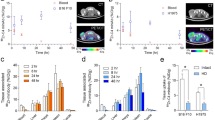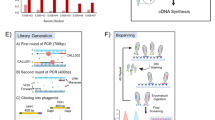Abstract
The ability of engineered antibodies to rapidly and selectively target tumors that express their target antigen makes them well suited for use as radioimaging tracers. The combination of molecular size and bivalent nature makes diabody molecules a particularly promising structure for use as radiotracers for diagnostic imaging. Previous data have demonstrated that the anti-HER2 C6.5 diabody (C6.5db) is an effective radiotracer in preclinical models of HER2-positive cancer. The aim of this study was to evaluate the impact on radiotracer performance, associated with expressing the C6.5db in the Pichia pastoris (P-C6.5db) system as compared to Escherichia coli (E. C6.5db). Glycosylation of P-C6.5db led to faster blood clearance and lower overall tumor uptake than seen with E. coli-produced C6.5db. However, P-C6.5db achieved high tumor/background ratios that are critical for effective imaging. Dosimetry measurements determined in this study for both 124I-P-C6.5db and 124I-E-C6.5db suggest that they are equivalent to other radiotracers currently being administered to patients.




Similar content being viewed by others
References
Miles KA, Williams RE. Warburg revisited: imaging tumour blood flow and metabolism. Cancer Imaging. 2008;8:81–6.
Kelloff GJ, et al. Progress and promise of FDG-PET imaging for cancer patient management and oncologic drug development. Clin Cancer Res. 2005;11(8):2785–808.
Holbro T, Hynes NE. ErbB receptors: directing key signaling networks throughout life. Annu Rev Pharmacol Toxicol. 2004;44:195–217.
Slamon DJ, et al. Studies of the HER-2/neu proto-oncogene in human breast and ovarian cancer. Science. 1989;244(4905):707–12.
Sliwkowski MX, et al. Nonclinical studies addressing the mechanism of action of trastuzumab (Herceptin). Semin Oncol. 1999;26(4 Suppl 12):60–70.
Slamon DJ, et al. Use of chemotherapy plus a monoclonal antibody against HER2 for metastatic breast cancer that overexpresses HER2. N Engl J Med. 2001;344(11):783–92.
Piccart-Gebhart MJ, et al. Trastuzumab after adjuvant chemotherapy in HER2-positive breast cancer. N Engl J Med. 2005;353(16):1659–72.
Cobleigh MA, et al. Multinational study of the efficacy and safety of humanized anti-HER2 monoclonal antibody in women who have HER2-overexpressing metastatic breast cancer that has progressed after chemotherapy for metastatic disease. J Clin Oncol. 1999;17(9):2639–48.
Vogel CL, et al. Efficacy and safety of trastuzumab as a single agent in first-line treatment of HER2-overexpressing metastatic breast cancer. J Clin Oncol. 2002;20(3):719–26.
Zuckier LS, DeNardo GL. Trials and tribulations: oncological antibody imaging comes to the fore. Semin Nucl Med. 1997;27(1):10–29.
Reddy S, Robinson MK. Immuno-positron emission tomography in cancer models. Semin Nucl Med. 2010;40(3):182–9.
Dijkers EC, et al. Biodistribution of 89Zr-trastuzumab and PET imaging of HER2-positive lesions in patients with metastatic breast cancer. Clin Pharmacol Ther. 2010;87(5):586–92.
Sundaresan G, et al. 124I-labeled engineered anti-CEA minibodies and diabodies allow high-contrast, antigen-specific small-animal PET imaging of xenografts in athymic mice. J Nucl Med. 2003;44(12):1962–9.
Lepin EJ, et al. An affinity matured minibody for PET imaging of prostate stem cell antigen (PSCA)-expressing tumors. Eur J Nucl Med Mol Imaging. 2010;37(8):1529–38.
Olafsen T, Kenanova VE, Wu AM. Tunable pharmacokinetics: modifying the in vivo half-life of antibodies by directed mutagenesis of the Fc fragment. Nat Protoc. 2006;1(4):2048–60.
Reddy S, et al. Evaluation of the anti-HER2 C6.5 diabody as a PET radiotracer to monitor HER2 status and predict response to trastuzumab treatment. Clin Cancer Res. 2011;17(6):1509–20.
Adams GP, et al. Prolonged in vivo tumour retention of a human diabody targeting the extracellular domain of human HER2/neu. Br J Cancer. 1998;77(9):1405–12.
Robinson MK, et al. Quantitative immuno-positron emission tomography imaging of HER2-positive tumor xenografts with an iodine-124 labeled anti-HER2 diabody. Cancer Res. 2005;65(4):1471–8.
Kogelberg H, et al. Clearance mechanism of a mannosylated antibody–enzyme fusion protein used in experimental cancer therapy. Glycobiology. 2007;17(1):36–45.
Trimble RB, et al. Structure of oligosaccharides on Saccharomyces SUC2 invertase secreted by the methylotrophic yeast Pichia pastoris. J Biol Chem. 1991;266(34):22807–17.
Jefferis R. Glycosylation of recombinant antibody therapeutics. Biotechnol Prog. 2005;21(1):11–6.
Wacker C, et al. Glycosylation profiles of therapeutic antibody pharmaceuticals. Eur J Pharm Biopharm. 2011;79(3):503–7.
Tolner B, et al. Production of recombinant protein in Pichia pastoris by fermentation. Nat Protoc. 2006;1(2):1006–21.
Horak E, et al. Isolation of scFvs to in vitro produced extracellular domains of EGFR family members. Cancer Biother Radiopharm. 2005;20(6):603–13.
Adams GP, et al. Delivery of the alpha-emitting radioisotope bismuth-213 to solid tumors via single-chain Fv and diabody molecules. Nucl Med Biol. 2000;27(4):339–46.
Stabin MG, Sparks RB, Crowe E. OLINDA/EXM: the second-generation personal computer software for internal dose assessment in nuclear medicine. J Nucl Med. 2005;46(6):1023–7.
Robinson MK, Weiner LM, Adams GP. Improving monoclonal antibodies for cancer therapy. Drug Dev Res. 2004;61:172–87.
Adams GP, et al. Increased affinity leads to improved selective tumor delivery of single-chain Fv antibodies. Cancer Res. 1998;58(3):485–90.
Gayed I, et al. The role of 18F-FDG PET in staging and early prediction of response to therapy of recurrent gastrointestinal stromal tumors. J Nucl Med. 2004;45(1):17–21.
Stroobants S, et al. 18FDG-Positron emission tomography for the early prediction of response in advanced soft tissue sarcoma treated with imatinib mesylate (Glivec). Eur J Cancer. 2003;39(14):2012–20.
Kapty J, Murray D, Mercer J. Radiotracers for noninvasive molecular imaging of tumor cell death. Cancer Biother Radiopharm. 2010;25(6):615–28.
Yu JQ, Cristofanilli M. Circulating tumor cells and PET. J Nucl Med. 2011;52(10):1501–4.
Barwick T, et al. Molecular PET and PET/CT imaging of tumour cell proliferation using F-18 fluoro-L-thymidine: a comprehensive evaluation. Nucl Med Commun. 2009;30(12):908–17.
Gagel B, et al. [18F] fluoromisonidazole and [18F] fluorodeoxyglucose positron emission tomography in response evaluation after chemo-/radiotherapy of non-small-cell lung cancer: a feasibility study. BMC Cancer. 2006;6:51.
Murakami Y, et al. 18F-labelled annexin V: a PET tracer for apoptosis imaging. Eur J Nucl Med Mol Imaging. 2004;31(4):469–74.
Liu A, et al. Fluorine-18-labeled androgens: radiochemical synthesis and tissue distribution studies on six fluorine-substituted androgens, potential imaging agents for prostatic cancer. J Nucl Med. 1992;33(5):724–34.
Choe YS, et al. Synthesis of 11 beta-[18F]fluoro-5 alpha-dihydrotestosterone and 11 beta-[18F]fluoro-19-nor-5 alpha-dihydrotestosterone: preparation via halofluorination-reduction, receptor binding, and tissue distribution. J Med Chem. 1995;38(5):816–25.
Beattie BJ, et al. Pharmacokinetic assessment of the uptake of 16beta-18F-fluoro-5alpha-dihydrotestosterone (FDHT) in prostate tumors as measured by PET. J Nucl Med. 2010;51(2):183–92.
Medzihradszky KF, et al. Glycoforms obtained by expression in Pichia pastoris improve cancer targeting potential of a recombinant antibody–enzyme fusion protein. Glycobiology. 2004;14(1):27–37.
Brierley RA. Secretion of recombinant human insulin-like growth factor I (IGF-I). Methods Mol Biol. 1998;103:149–77.
Li H, et al. Optimization of humanized IgGs in glycoengineered Pichia pastoris. Nat Biotechnol. 2006;24(2):210–5.
Gordon S. Pattern recognition receptors: doubling up for the innate immune response. Cell. 2002;111(7):927–30.
Bhatia J, et al. Catalytic activity of an in vivo tumor targeted anti-CEA scFv:carboxypeptidase G2 fusion protein. Int J Cancer. 2000;85(4):571–7.
Bretthauer RK, Castellino FJ. Glycosylation of Pichia pastoris-derived proteins. Biotechnol Appl Biochem. 1999;30(Pt 3):193–200.
Oude Munnink TH. (89)Zr-trastuzumab PET visualises HER2 downregulation by the HSP90 inhibitor NVP-AUY922 in a human tumour xenograft. Eur J Cancer. 2010;46(3):678–84.
Divgi CR, et al. Preoperative characterisation of clear-cell renal carcinoma using iodine-124-labelled antibody chimeric G250 (124I-cG250) and PET in patients with renal masses: a phase I trial. Lancet Oncol. 2007;8(4):304–10.
Jayson GC, et al. Molecular imaging and biological evaluation of HuMV833 anti-VEGF antibody: implications for trial design of antiangiogenic antibodies. J Natl Cancer Inst. 2002;94(19):1484–93.
Lee CL, et al. Radiation dose estimation using preclinical imaging with 124I-metaiodobenzylguanidine (MIBG) PET. Med Phys. 2010;37(9):4861–7.
Gonzalez Trotter DE. Quantitation of small-animal (124)I activity distributions using a clinical PET/CT scanner. J Nucl Med. 2004;45(7):1237–44.
Acknowledgments
This work was supported in part by a HRSA grant to the American Russian Cancer Alliance and through support by an appropriation from the Commonwealth of Pennsylvania. Part of this work was supported by The Breast Cancer Campaign, UK. We thank G. Adams for scientific discussions. We acknowledge the Laboratory Animal Facility and the Instrument Shop at the Fox Chase Cancer Center for their expert technical assistance.
Conflicts of interest
Matthew Robinson is a member of the Scientific Advisory Board of Avipep, Pty Ltd. Avipep has licensed the C6.5db from University of California, San Francisco.
Author information
Authors and Affiliations
Corresponding author
Electronic supplementary material
Below is the link to the electronic supplementary material.
ESM 1
(PDF 519 kb)
Rights and permissions
About this article
Cite this article
Miller, J., Doss, M., McQuillen, R. et al. Impact of expression system on the function of the C6.5 diabody PET radiotracer. Tumor Biol. 33, 617–627 (2012). https://doi.org/10.1007/s13277-012-0361-z
Received:
Accepted:
Published:
Issue Date:
DOI: https://doi.org/10.1007/s13277-012-0361-z




